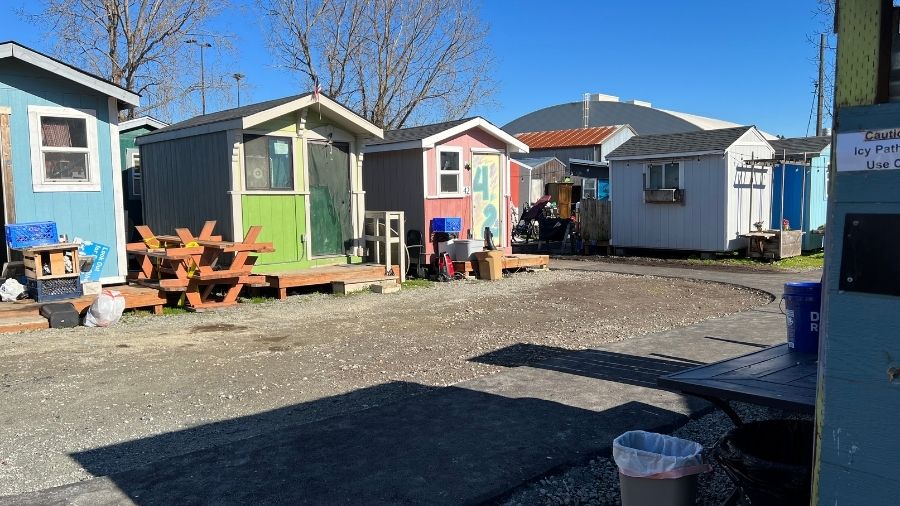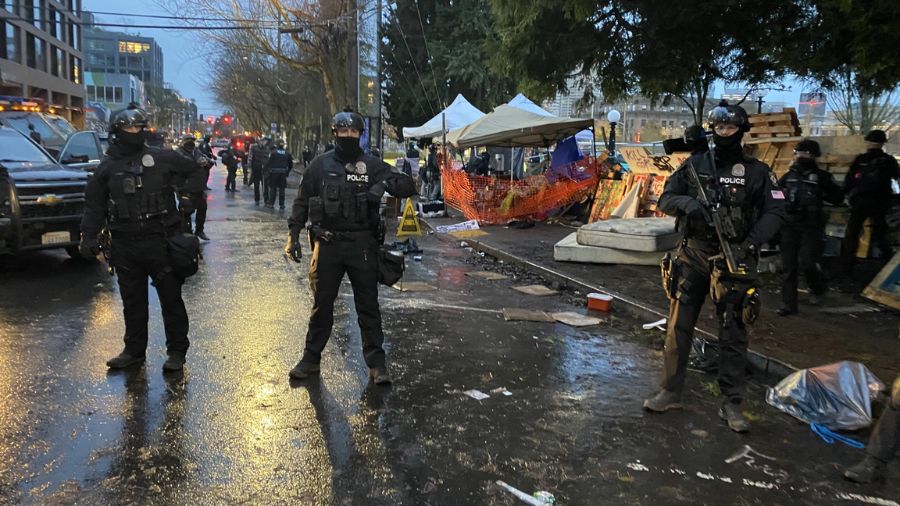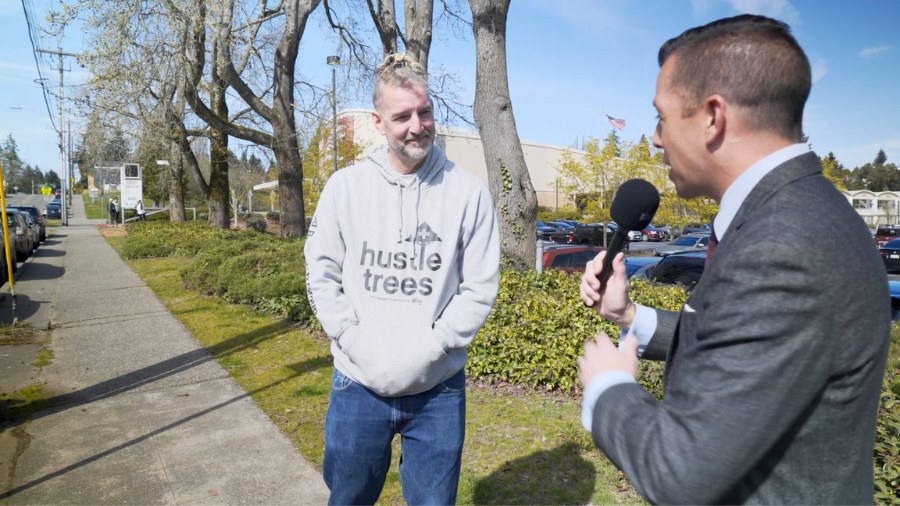Rantz: Homeless addict dies at Seattle Tiny House Village, drugs rampant as program slowly kills
Mar 8, 2022, 6:00 PM | Updated: Mar 9, 2022, 7:58 am
At 10:45 p.m. on Feb. 10, Seattle police informed Scott Townson that his 32-year-old son Jeremy was found dead inside the Georgetown Tiny House Village. The home was on fire at the time.
Townson says the medical examiner told him that his son died five days earlier than when he was found.
Just about a month shy of his birthday, Jeremy died an addict. Despite seemingly endless attempts at treatment, Jeremy fell deeper into his addiction. He became homeless, living on the streets of Seattle before entering the Tiny House Village in Georgetown, operated by the Low Income Housing Institute (LIHI).
Like its other properties, despite disingenuous protestations, this village allows addicts to continue using. While LIHI does not permit substance abuse in public spaces or outside, addicts continue to abuse drugs and alcohol inside their tiny house.
This program, along with state laws that made it nearly impossible for parents to get their teens treated for addiction, helped lead to Jeremy’s early death.
Rantz: Dangerous homeless addicts take over park, terrorize Seattle neighborhood
The dreaded phone call
It’s not a phone call that Scott Townson ever wanted to take, but it’s one he expected.
“This whole thing has taken 20 years and it’s been horrible,” Townson told the Jason Rantz Show on KTTH. “And we’ve tried so hard to get him the help that he needs. He’d been in and out of rehab so many times that I lost count.”
Jeremy became an addict when he was 13 years old. Townson says his son was introduced to meth by kids in school and was soon overcome by the addiction.
“It just wrecked him, yeah. And the smile — the first thing you noticed is the smile disappears. They’re not smiling anymore. And that’s really sad because he had a beautiful smile,” Townson said.
The cause of death
Townson assumed the cause of death was a drug overdose; that maybe he technically died due to the smoke from the fire in his tiny house, but that he slept through it because of his addiction.
“When we went to the funeral home to complete the death certificate we found out that the M.E. had set the date of death as 2/5/22, not 2/10/22 when we were contacted,” Townson emailed the Jason Rantz Show on KTTH. “This meant that he had been deceased for 5 days without anyone noticing that the place was smoldering. His cause of death was determined as accidental toxic smoke inhalation with an underlying drug use.”
Local firefighters say sometimes it’s difficult to notice if someone is dead in a tiny house village. Though a decomposing body creates a scent that’s hard to ignore, trash at these encampments may cover the stench.
Kidnapped for rehab
As Scott Townson and his wife sought treatment for Jeremy, they soon found out that Washington made it difficult.
Up until the passage of the Adolescent Behavioral Health Care Access Act in 2020, parents could not get their minor child into treatment unless the child consented. Jeremy did not consent.
Desperate to help his teenage son, Townson enlisted the assistance of an Oregon-based program that “kidnapped” Jeremy to bring him to their treatment facilities. But once Jeremy was done with the program and back in Washington, Townson had no help due to laws at the time.
“Oregon has different laws, and they came up here and they transported him down, which did some good,” he said. “I mean, it gave us a little bit of a break when we really needed it because everything was going upside down for us. We knew at least he was safe where he was at. But the minute you get him home, you lose your safety net. We don’t have any support up here. They’ve taken it all away.”
Since then, Townson says Jeremy has been in and out of rehab, drug courts, jail, and the hospital.
Jeremy ends up homeless
Perhaps it was inevitable. Addled by addiction, Jeremy became homeless after years of support from his family.
“We actually supported him in a house and an apartment for a while. But it got so bad. I had to sell the house, so we put him in the apartment,” Townson explained. “He’d go in and out of rehab, you get a job, you’d be OK. He was doing OK. Then he fell off again and we didn’t know it. And, of course, then he got kicked out of the apartment building after he trashed the place.”
After living on the streets, Jeremy landed in one of LIHI’s Tiny House Villages.
Nestled in a more industrial neighborhood, the small village in Georgetown doesn’t cause the same trouble as other villages that are closer to residential and business areas. But it’s not helping the residents as advertised.
Rantz: Seattle police say video shows homeless man hitting woman in head with bat
Drug and alcohol abuse is rampant
LIHI adopts the Housing First model, which offers a home without meaningful conditions. That means addicts can continue to use.
“All residents agree to our Code of Conduct, which prohibits use of drugs and alcohol in public spaces within the village or the surrounding neighborhood,” LIHI’s Director of Advocacy & Community Engagement Josh Castle emailed the Jason Rantz Show on KTTH. “As long as residents are working with our case managers (also required in the Code of Conduct) and otherwise adhering to the Code of Conduct we continue to work with them to reduce their harm, to recover from the trauma of living outside, and to get on a path to permanent housing.”
This allows an addict to continue to use in their tiny house, which is suspected of Jeremy.
On a recent visit to the village, residents and a staffer acknowledged the rampant drug use occurring at the village. While I was there, a resident was calling 911, begging for someone to come to help her alcoholic boyfriend, another resident. She was scared he’d hurt himself. This wasn’t the first time she’d call.
“Our case managers work with every resident as an individual in identifying and overcoming barriers to housing and work to transition residents as quickly as possible into permanent housing, the ultimate goal of the program,” Castle explained. “A substance use disorder is certainly one of those challenges and case managers work with individuals experiencing substance use disorder on reducing harm to themselves and on enrolling into treatment and recovery programs.”
What are LIHI’s successes?
Since March 2, LIHI promised to deliver specific data on its success rates over the last five years. But they haven’t provided answers as of this story’s publication. Now, Castle is out of town and not responding to emails.
I asked Castle for the rate of village residents getting into non-subsidized housing versus subsidized, transitional housing. I also asked how often residents leave the village to become homeless again.
Castle did, however, provide a one-sheet on successes for 2021.
LIHI claims that 56% of its 745 residents in 2021 ended up in permanent housing. Of those who move out, 65% leave in under six months. But the vast majority, the sheet acknowledges, require subsidies. It’s also not clear how many stayed in the housing and received successful treatment for their underlying condition (if they had any).
Washington looks for investments in tiny house villages
Despite the relatively little effort from LIHI or its advocates to promote its successes, Governor Jay Inslee is joining the push to expand tiny house villages.
Inslee recently toured a Seattle tiny house village managed by LIHI. He’s advocating for $350 million to go towards expanding the program. But Republican lawmakers are pointing out that these programs are not transparent about their results. Inslee pretended he has not heard of any complaints from Republicans.
“Well, I actually do not hear that,” Inslee said to KOMO TV’s Jonathan Choe. “I don’t know who you’re talking about. People are thrilled about this type of investment.”
But during that same tour, LIHI’s high-paid Executive Director Sharon Lee refused to be transparent on a key issue plaguing these villages.
Visit any of the 10 villages LIHI manages in Seattle and you’ll likely see dozens of bikes. They’re almost all stolen. When Choe asked about the crimes, Lee called the KOMO reporter “nasty” for asking. She then asked to speak to his boss, unhappy that the reporter was asking questions.
“I want to speak to your manager and your supervisor because I don’t appreciate this,” she said.
Where things stand
As the state leans into tiny house villages as a solution to homelessness, more residents will find themselves living next to the chaos.
Townson wishes more could be done to help homeless addicts like his son. While he doesn’t wholly blame LIHI, he calls them out for allowing Jeremy “a safe place to use without having to deal with the rest of us.” He says it’s “just another mask” to the addiction.
“These places were supposed to be safe havens, not a place to slowly kill yourself with no one around sober enough to notice,” Townson said via email. “Jeremy’s days were counting down, he was only given a 10% chance to survive. He didn’t want to die, but he had given up hope. We couldn’t save Jeremy, his demons took him out.”
What is the answer to this complex crisis? How can policies better address the problem? It’s something Townson has spent considerable time trying to answer.
“The only way that we can help these people, unfortunately, is we’re going to have to give them choices, and they’re going to be difficult choices,” he said. “They’re either going to have to get clean, or they’re going to have to leave, or they’re going to have to get jail — which they’ll get clean. But letting them kill themselves on the street? I don’t think it’s a really good answer.”
Listen to the Jason Rantz Show weekday afternoons from 3–6 pm on KTTH 770 AM (HD Radio 97.3 FM HD-Channel 3). Subscribe to the podcast here. Follow @JasonRantz on Twitter, Instagram, and Facebook. Check back frequently for more news and analysis.






















